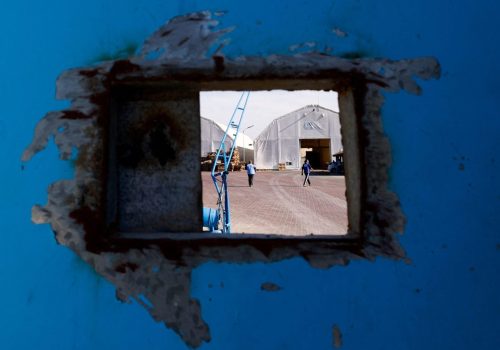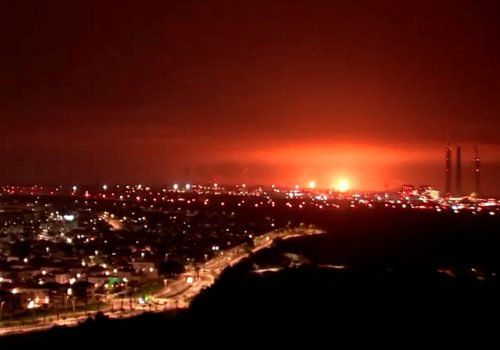A Marine’s view: What Israeli ground forces will face in Gaza
After Hamas’s monstrous terrorist attack across southern Israel on October 7, the Israeli government announced that it planned to eradicate the terrorist organization once and for all. It is easy to understand why. The attack killed 1,400 Israelis and at least thirty Americans, mostly unarmed civilians, including women and children, many of whom were raped and tortured before their deaths. Their murders were filmed by Hamas and posted on the internet for the world to see. More than two hundred Israeli and American citizens were taken hostage. It was the largest atrocity committed against the Jewish people since the Holocaust.
Following the October 7 attack, the Israel Defense Forces (IDF) tightened border security, increased its maritime interdiction of weapons flowing into Gaza, and began shaping operations in Gaza with air strikes, surface fires, and ground operations against targets in Gaza. The IDF has called up its reserves, and a force of at least 350,000 awaits its orders to begin a larger ground invasion. With Israeli Prime Minister Benjamin Netanyahu’s announcement on October 28 that a “second stage” in Israel’s war against Hamas has begun, it now seems a question of when, not if, the order for a large number of these troops to cross the border will come. When it does, the challenges the IDF will face will be intense. I have some sense of these challenges from firsthand experience doing urban close air support between 2001 and 2007 in Nasiriyah, Baghdad, Ramadi, Fallujah, Kandahar, and around al-Qaim.
First among the challenges will be the difficulty that a densely packed urban environment such as Gaza City poses to military operations. During military operations on urban terrain, or MOUT, every building is a potentially hardened bunker from which an enemy can launch an ambush. Patrols of infantrymen only a block apart will not be able to see or support each other with fire. Efforts to evacuate the wounded will be slowed by the lack of landing zones to support medical evacuations by helicopter. Though Hamas has no air assets, the verticality of the urban landscape will allow it to bring fire down on the IDF from above, necessitating the need for the Israeli Air Force to provide close air support, often at “danger close” range. Hamas can easily turn everyday items in the city, such as parked cars, garbage cans, or mailboxes, into improvised explosive devices. Hamas’s extensive network of tunnels adds a third subsurface element to the battlespace, akin to the challenge submarines pose to naval surface forces.
Unlike Hamas, Israeli forces operate under the order to minimize both civilian casualties and the destruction of infrastructure.
Israeli airstrikes since October 7 have caused civilian deaths in Gaza despite Israel’s best efforts to avoid them. A large ground invasion will undoubtedly result in more deaths of innocent Palestinians unconnected to Hamas. Wars exact high human costs, and there is no reason to expect ground operations in Gaza to deviate from the pattern. Unlike Hamas, Israeli forces operate under the order to minimize both civilian casualties and the destruction of infrastructure. This is the right approach, but it is also one that will make Israel’s mission to destroy Hamas more difficult. Israeli soldiers will advance slower as they clear buildings room by room and attempt to disarm improvised explosive devices, rather than level city blocks with overwhelming firepower. Over the course of its ground campaign, the IDF will plan to evacuate wounded soldiers, civilians, and terrorists, a position starkly in contrast to Hamas’s use of Palestinians and hostages as human shields.
Fortunately, the IDF is a well-trained military. It pioneered employing unmanned aircraft systems to assist in urban targeting and reconnaissance, including the use of small handheld systems that can look around corners for patrols and clear rooms before soldiers risk their lives. The IDF’s experience in years of urban warfare was of great benefit to the US military in Operation Enduring Freedom and Operation Iraqi Freedom, and the IDF has incorporated lessons learned from US warfare into its tactics, techniques, and procedures.
If the challenge of urban warfare were all that Israel faced, it would be daunting enough. Unfortunately, Israeli forces also face an often hostile and ill-informed world press that holds Israel to a vastly different standard than they hold Hamas. For example, the phrases “proportionality” and the “law of war” are bandied about, with few seeming to understand what they mean fully. The principle of proportionality seeks to limit civilian casualties and collateral damage by ensuring the military force used is not disproportionate to meet legitimate military objectives. No reasonable person can fail to see the importance to Israel of protecting its citizens from mass murder, rape, and torture by Hamas. If Israel were to indiscriminately carpet bomb Gaza City, Hamas’s stronghold, then that would be a disproportionate use of force. Israel has not done that. It has instead called for civilian evacuations of northern Gaza and conducted airstrikes with precision weapons.
Hamas has repeatedly demonstrated its willingness to attack protected places in Israel and use hospitals and schools in Gaza for military operations.
The ground offensive Israel is likely planning will place its soldiers at increased risk, but it will also ensure to a much greater extent that only Hamas’s terrorists, operations centers, and weapons depots are targeted. The Geneva Conventions protect hospitals and places of worship from attack when they serve their proper functions, and to ignore those protections would constitute a war crime. However, if protected places are used for offensive military purposes, they may forfeit their protected status. Even if, for example, a site is being used as both a hospital and for military purposes, it still represents a viable target (and not a war crime) provided the attacking force gives advance warning before its attack and takes other precautionary measures. In this case, it is the side that abuses the protected status of the sites that is the one guilty of war crimes and is legally and morally responsible for civilian deaths and damage. Hamas has repeatedly demonstrated its willingness to attack without regard for protected places in Israel and to use hospitals and schools in Gaza as cover for military operations.
As events in Gaza unfold, the United States and its allies should stand with its fellow democracy, Israel, as it defends itself against terrorism. It is equally vital that the United States help defend Israel against the moral relativism that tries to equate Hamas’s deliberate targeting of protected civilians and the IDF’s scrupulous efforts to avoid harming innocent noncombatants.
Col. John B. Barranco USMC (Ret.) was the 2021-22 US Marine Corps senior fellow at the Atlantic Council’s Scowcroft Center for Strategy and Security and is currently executive vice president of Potomac International Partners and an adjunct professor at the Naval War College.
Further reading
Tue, Oct 24, 2023
The global consequences of the Israel-Hamas war are just beginning. Here’s what to watch.
The Big Story By Kirsten Fontenrose
It’s hard to predict what decisions the players will make tomorrow, but here are the early warning signs that could indicate what will come next in the Middle East and beyond.
Sat, Oct 28, 2023
Israel’s ground war in Gaza has started. How will it end?
Fast Thinking By Atlantic Council
On October 28, Israeli Prime Minister Benjamin Netanyahu announced that a “second stage” in Israel’s war is intended to destroy Hamas in Gaza. Atlantic Council experts share their insights.
Fri, Oct 27, 2023
Experts react: What to know about Israel’s expanding military operations in Gaza
New Atlanticist By Atlantic Council experts
In what could signal the initial steps of a larger invasion, Israel has announced that it is “expanding” ground operations in Gaza, with the goal of eradicating Hamas.
Image: Southern Israel.- In the photos, Israeli forces are deployed in southern Israel on October 31, 2023. Israeli troops and tanks attacked the main city in northern Gaza from both sides, three days after they began a major offensive land. The Israeli military said it has struck more than 600 militant targets in recent days as it expands ground operations in the Gaza Strip.
Related Posts



